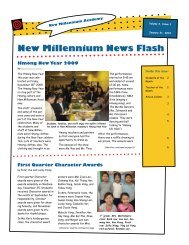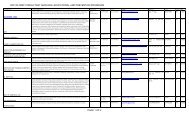The Unification of China - District Home
The Unification of China - District Home
The Unification of China - District Home
You also want an ePaper? Increase the reach of your titles
YUMPU automatically turns print PDFs into web optimized ePapers that Google loves.
Summarizing<br />
How did the<br />
Legalists think that<br />
a society could be<br />
made to run well?<br />
After all, it was for the prince to govern and the people to obey. Eventually,<br />
Legalist ideas gained favor with a prince <strong>of</strong> a new dynasty that replaced the<br />
Zhou. That powerful ruler soon brought order to <strong>China</strong>.<br />
I Ching and Yin and Yang People with little interest in the philosophical<br />
debates <strong>of</strong> the Confucians, Daoists, and Legalists found answers to<br />
life’s questions elsewhere. Some consulted a book <strong>of</strong> oracles called<br />
I Ching (also spelled Yi Jing) to solve ethical or practical problems.<br />
Readers used the book by throwing a set <strong>of</strong> coins, interpreting the results,<br />
and then reading the appropriate oracle, or prediction. <strong>The</strong> I Ching (<strong>The</strong> Book<br />
<strong>of</strong> Changes) helped people to lead a happy life by <strong>of</strong>fering good advice and simple<br />
common sense.<br />
Other people turned to the ideas <strong>of</strong> ancient thinkers, such as the concept <strong>of</strong> yin<br />
and yang—two powers that together represented the natural rhythms <strong>of</strong> life. Yin<br />
represents all that is cold, dark, s<strong>of</strong>t, and mysterious. Yang is the opposite—warm,<br />
bright, hard, and clear. <strong>The</strong> symbol <strong>of</strong> yin and yang is a circle divided into halves,<br />
as shown in the emblem to the upper right. <strong>The</strong> circle represents the harmony <strong>of</strong><br />
yin and yang. Both forces represent the rhythm <strong>of</strong> the universe and complement<br />
each other. Both the I Ching and yin and yang helped Chinese people understand<br />
how they fit into the world.<br />
<strong>The</strong> Qin Dynasty Unifies <strong>China</strong><br />
In the third century B.C., the Qin Dynasty (chihn) replaced the Zhou Dynasty. It<br />
emerged from the western state <strong>of</strong> Qin. <strong>The</strong> ruler who founded the Qin Dynasty<br />
employed Legalist ideas to subdue the warring states and unify his country.<br />
A New Emperor Takes Control In 221 B.C., after ruling for over 20 years, the Qin<br />
ruler assumed the name Shi Huangdi (shihr hwahng•dee), which means “First<br />
Emperor.” <strong>The</strong> new emperor had begun his reign by halting the internal battles that<br />
had sapped <strong>China</strong>’s strength. Next he turned his<br />
attention to defeating invaders and crushing resistance<br />
within <strong>China</strong> to his rule. Shi Huangdi’s armies<br />
attacked the invaders north <strong>of</strong> the Huang He and<br />
south as far as what is now Vietnam. His victories<br />
doubled <strong>China</strong>’s size. Shi Huangdi was determined<br />
to unify <strong>China</strong>.<br />
Shi Huangdi acted decisively to crush political<br />
opposition at home. To destroy the power <strong>of</strong> rival<br />
warlords, he introduced a policy called “strengthening<br />
the trunk and weakening the branches.” He commanded<br />
all the noble families to live in the capital<br />
city under his suspicious gaze. This policy, according<br />
to tradition, uprooted 120,000 noble families.<br />
Seizing their land, the emperor carved <strong>China</strong> into 36<br />
administrative districts. He sent Qin <strong>of</strong>ficials to<br />
control them.<br />
To prevent criticism, Shi Huangdi and his prime<br />
minister, the Legalist philosopher Li Su, murdered<br />
hundreds <strong>of</strong> Confucian scholars. <strong>The</strong>y also ordered<br />
“useless” books burned. <strong>The</strong>se books were the works<br />
<strong>of</strong> Confucian thinkers and poets who disagreed with<br />
the Legalists. Practical books about medicine and<br />
farming, however, were spared. Through measures<br />
▲ Traditional<br />
yin-and-yang<br />
symbol<br />
▼ Although a<br />
tyrant, Shi<br />
Huangdi is<br />
considered the<br />
founder <strong>of</strong><br />
unified <strong>China</strong>.<br />
<strong>The</strong> word Qin is<br />
the origin <strong>of</strong><br />
<strong>China</strong>.<br />
First Age <strong>of</strong> Empires 107








